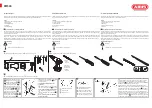
model no. 058-1294-8 | contact us 1-800-689-9928
OPERATING INSTRUCTIONS
OPERATING INSTRUCTIONS
11
10
The welding electrode is a rod coated with a layer of flux. When welding, electrical current
flows between the electrode (rod) and the grounded metal workpiece. The intense heat of the arc
between the rod and the grounded metal melts the electrode and the flux. The most popular
electrodes are:
—E6011 60,000 PSI tensile strength for deep penetrating applications.
—E6013 60,000 PSI tensile strength used for poor fit-up applications.
—E7014 70,000 PSI tensile strength used for high deposition and fast travel speeds with
light penetration.
—E7018 70,000 PSI tensile strength (not suitable for this welder).
This welder is capable of welding with 1/16" (1.6 mm) and 5/64" (2 mm) and 3/32" (2.4 mm)
electrodes.
WELDING POSITION
There are two basic positions for welding: flat and horizontal. Flat welding is generally easier, faster, and
allows for better penetration. If possible, the workpiece should be positioned so that the bead will run on a
flat surface.
PREPARING THE JOINT
Before welding, the surface of the workpiece must be free of dirt, rust, scale, oil or paint, which create a
brittle and porous weld. If the base metal pieces to be joined are thick or heavy, it may be necessary to
bevel the edges with a metal grinder. The correct bevel should be around 60 degrees. See following picture:
Based on different welding positions, there are different welding joints; see following images for more
information:
GROUND CLAMP CONNECTION
Clear any dirt, rust, scale, oil or paint on the ground clamp. Make certain you have a good solid ground
connection. A poor connection at the ground clamp will waste power and heat. Make sure the ground clamp
touches the metal.
OPERATING INSTRUCTIONS
ELECTRODE SELECTION
model no. 058-1294-8 | contact us 1-800-689-9928
model no. 058-1294-8 | contact us 1-800-689-9928
model no. 058-1294-8 | contact us 1-800-689-9928
model no. 058-1294-8 | contact us 1-800-689-9928






























